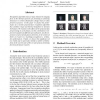Free Online Productivity Tools
i2Speak
i2Symbol
i2OCR
iTex2Img
iWeb2Print
iWeb2Shot
i2Type
iPdf2Split
iPdf2Merge
i2Bopomofo
i2Arabic
i2Style
i2Image
i2PDF
iLatex2Rtf
Sci2ools
AVSS
2006
IEEE
2006
IEEE
On Person Authentication by Fusing Visual and Thermal Face Biometrics
Recognition algorithms that use data obtained by imaging faces in the thermal spectrum are promising in achieving invariance to extreme illumination changes that are often present in practice. In this paper we analyze the performance of a recently proposed face recognition algorithm that combines visual and thermal modalities by decision level fusion. We examine (i) the effects of the proposed data preprocessing in each domain, (ii) the contribution to improved recognition of different types of features, (iii) the importance of prescription glasses detection, in the context of both 1-to-N and 1-to-1 matching (recognition vs. verification performance). Finally, we discuss the significance of our results and, in particular, identify a number of limitations of the current state-of-the-art and propose promising directions for future research.
AVSS 2006 | Decision Level Fusion | Face Recognition Algorithm | Recognition Algorithm | Signal Processing |
Related Content
| Added | 10 Jun 2010 |
| Updated | 10 Jun 2010 |
| Type | Conference |
| Year | 2006 |
| Where | AVSS |
| Authors | Ognjen Arandjelovic, Riad I. Hammoud, Roberto Cipolla |
Comments (0)

